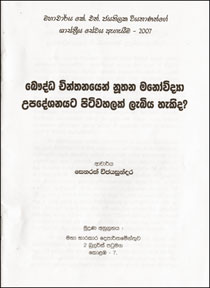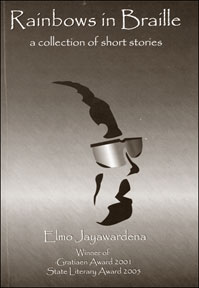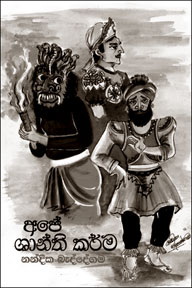
‘Service to humanity is the worship of the Buddha’
Reviewed
by Prof. Emeritus Jayadeva Tilakasiri
It is said that at least one out of eight Sri Lankans in our
contemporary society is subject to some sort of mental problem or
disorder!
 Therefore, it is obviously a grave problem that we cannot overlook.
Consequently, it is our duty to come out with some proper ways and
methods to meet this unfortunate situation. Therefore, it is obviously a grave problem that we cannot overlook.
Consequently, it is our duty to come out with some proper ways and
methods to meet this unfortunate situation.
The number of psychiatrists and counsellors do not seem to be
sufficient to face this problem. Psychiatry and psychology, subjects we
have received from the West, are fast developing and trying to solve
these problems through new techniques.
Their therapeutic techniques are followed in both sectors. Government
as well as private. Under such a situation it is quite relevant to find
out whether Buddhism can participate and contribute in the attempt to
serve those who are suffering.
Dr. Senerat Wijayasundara graduated from the Peradeniya University
specialising in Philosophy under the late Professor K.N. Jayatilleke in
whose memory this lecture was delivered. He serves as a Lecturer in the
Department of Philosophy of Kelaniya University for ten years teaching
Philosophy and Psychology.
Later he joined the editorial staff of the Encyclopedia of Buddhism.
In addition to the depth of learning of Theravada Buddhism, he has also
gained a good grasp of Mahayana and Tantrayana aspects of Buddhism as
well.
Together with his first field of study he devoted his time to the
study of Psychotherapy and Counselling and attended the courses in these
subjects in India, Singapore and Malaysia.
With that background and learning he is trying to understand how far
Buddhism can contribute to bring solace to those who are subject to
serious types of mental problems and disorders.
This memorial lecture is one such attempt he has made. In this
lecture he has mentioned fourteen cases from Buddhist texts where we
find instances similar to those in the practice of Psychotherapy and
Counselling. But he has dealt with two instances in some detail.
The first instance is the one when the Buddha delivered His first
sermon to a not very sympathetic audience. The other is where, lying on
His deathbed, just before Enlightenment, the Buddha found time to
clarify a controversial problem posed by a wandering monk, Subadda by
name.
These can be taken as two illuminating examples that the Buddha
efficiently dealt with.
In the course of the discussion the speaker also introduced six
fundamentals on which the Buddhist attitude to mental problems and
disorders can be built up.
These six points are: (1) Impermanence, (2) Suffering, (3)
Soullessness, (4) Dependent Origination, (5) Free-will and (6) Three
factors leading to rebirth i.e. sexual union of parents, mother at the
proper period and the arrival of the Gandhabba (the presence of linking
Consciousness).
On this topic he has quoted the well-known Cambridge Psychologist,
Robert H. Thouless. In his booklet, Christianity and Buddhism, Thouless
while accepting “Buddhism is a system of psychotherapy also concerned
with relief from emotional burdens not only for the sake of this life
but also for the sake of future lives in which these burdens may have to
be carried if they are not got rid of now.”
If we consider the problems and difficulties that arise today in
various ways the complex nature is quite apparent.
Therefore, counselling as a service is of immense value in finding
solutions and obtaining guidance. Despite the presence of shortcomings,
mental therapy is quite beneficial to human beings.
Educational institutes as well as offices and public companies should
make use of this medium of counselling in their activities and thus
achieve harmony and effective management.
Dr. Wijayasundara must be congratulated in his attempt to look into
Buddhist thought and show the public the nature of the material that
Buddhist literature contains on the subject. The Speakers’ message is
clear in that he called for the practice of the Buddhist methods and
their application in living and yearning for their revival among the
educated people.
Such an attempt on their part would no doubt lead to the ‘development
and widening for them for the good of humanity. At the end of the
lecture he has aptly quoted the Indian Brahamin Buddhist, Ramachandra
Bharati as follows: “Service to humanity is the worship of the Buddha.”
When you are in Rome...
Rainbows in Braille - a collection of short stories by Elmo
Jayawardena the winner of Gratien Award 2001 and State Literary Award
2005
Reviewed by Sureka Galaboda
[email protected]
|

Rainbows in Braille - a collection of short stories by Elmo
Jayawardena the winner of Gratien Award 2001 and State Literary
Award 2005 |
The forward written by none other than much loved statesman Bradman
Weerakoon amply explains the book. “Rainbows in Braille is Capt Elmo
Jayawardena’s maiden foray into the genre of the short story. But as you
read through this collection of 19 short stories you see at work already
a master craftsman of the art of story telling. Like Everything else
that Elmo has done in his exciting life the readers of his novels will
notice the ease with which he has moved into this new form of story
telling.”
Believe me you can read all 19 stories in one breath and once you
finish reading one you think that it is better than the previous one
since the theme as well as the words used by Capt Elmo are simple and
easy to understand which I am sure will make everybody who reads it love
the book.
Specially the people of Moratuwa and the people who pass this city
can relate to some of the places he refers to in his stories. Most of
all the royalties of this book are mainly used for the work of AFLAC
International an approved charity in Sri Lanka engaged in humanitarian
work of which the author, Capt Elmo Jayawardena is the
Founder/President.
The book depicts the simple instances in life undergone by people of
less fortune and his attention to detail about these people speak
volumes about his character and how he cares for them.
The story “When You are in Rome” is about an English Class in a boys
school in Moratuwa. He tells how the boys memorised the idioms and after
repeating the wrong idiom with the wrong pronounciation how they got
slapped by the master. His sense of humour adds colour to the story and
it is a true story.
Andy Roberts is a story of happiness and sadness mixed together and
how Andy lives happily ever after going through the rough seas.
The story Loser pays for the Bananas is about a bet of two men who
had to eat two bunches of plantains. A man bets saying that he and his
friend can finish two bunches of plantains whereas the other says that
they cannot even eat two full plantains. On the day of the bet he brings
his cow and they both eat and win the bet. Reading the story you are
sure to have a hearty laugh.
Some stories will make you feel sad while the others will make you
feel happy but all stories are related to human emotions and You will
enjoy reading them as much as I did because they were all penned by the
humble human being Capt. Elmo Jayawardena.
Can poets be human? Read on...
Title: “Sithivillak”
Author: Upali Ubayasekara
Reviewed by R.S. Karunaratne
Upali Ubayasekera’s latest anthology of Sinhala poems entitled
“Sithivillak” reaffirms the old notion that poetry, like painting and
music, is an art. It is not a form of “happy indulgence” a term coined
by Ivor Winters in “The Function of criticism.” In order to master an
art or even understand it, you have to labour with all your mind and
with at least a part of your body.
You do not have to labour too much to understand the poems written by
Ubayasekara because they have been written using the colloquial idiom.
For instance, the opening lines in “Mosthara Nirupikawakage Kalpanava”
evoke a mental picture:
“Kalupata gadget eka
Kana thiyan kiyevvata
Bila gevanne kavuda?”
(who pays the bill when you use the black mobile phone?)
The use of words like “gadget eka” and “bila” shows that the poet
follows the modern trends in poetry writing.
Most poems tell you a great deal provided you know how to read them
and listen to them. To do this effectively you have to know the poetic
language. The following lines from “Obath navathila balanna” are packed
with poetic images.
“Janelayen eha loke
Kerakena heti bala inna
Asai mata udu bellen
Seelima desa bala inna”
(I would love to look at the world through the window. I like to look
at the ceiling while lying flat on my bed.) Some people believe that
poets are different from other human beings. However, poets are neither
more nor less human than other people. Although the average Sri Lankan
does not pay much attention to poets, poetry is an activity as natural
as dancing, singing or working in an office.
The dialogue between socrates and his judges is something unusual I
happened to read in recent times. In the poem entitled “Kata vahagena
inna berida?” (Can’t you keep your mouth shut?) judges want socrates to
keep his mouth shut. But Socrates says that he cannot do so because it
is against God’s commands. He asks the judges to question themselves
whether they have wisdom and righteousness. Mark Socrates’ words:
“Tell me friends
can you punish a man
who has never amassed wealth
enriched his family
didn’t seek positions
didn’t waste time
in gossip
didn’t conspire
what type of punishment
would you give him?”
While reading this poem I felt a passionate sense of mystery in the
words. The mystery is couched in the poetic language.
Some critics believe that poets have no boundaries. However, it is
logical to say that poetry’s boundaries are man’s boundaries, neither
more nor less. “Debasak” - a dialogue probably between a husband and a
wife proves this point. The couple wants to pay a visit to their
parents.
The husband wants to go by a luxury bus. But the wife reminds him of
the perils of riding in a luxury bus: noise pollution with ear-splitting
baila and travelling in an enclosed area without ventilation. She
prefers to travel by an ordinary Latec bus in which she can sit close to
a window and see the passing people, trees, waterways and hills. What is
more, the wind will blow her hair to touch his face.
The few poems discussed here and several others found in the
anthology are pregnant with energy and passion. They evoke the reader’s
feelings wildly and bring him enjoyment and enlightenment.
Insight into Hinduism
Indhumatham Enna Solgirathu - part I
and Mangalap Porudkalin Mahathuvam - Part 2
Author Gnanam Gnanasekara Iyer
Published by: Gnanam Pathippagam
Reviewed by Kalabooshanam Chelvatamby Maniccavasagar
 The books on ‘Indhumatham Enna Solgirathu’ and ‘Mangalap Porudkalin
Mahathuvam’ written and published by Gnanam Gnanasekara Iyer who was a
former provincial co-ordinator (Hinduism) of the Department of
Education, Central Province, Kandy are of high standard since both these
books have wealth of information pertaining to Hinduism and reflect the
lifestyle of Hindus particularly in regard to religious rituals,
festivals, ceremonies, symbolism and the use of Mangalaporudkal like
flowers, fruits coconuts, camphor etc. The books on ‘Indhumatham Enna Solgirathu’ and ‘Mangalap Porudkalin
Mahathuvam’ written and published by Gnanam Gnanasekara Iyer who was a
former provincial co-ordinator (Hinduism) of the Department of
Education, Central Province, Kandy are of high standard since both these
books have wealth of information pertaining to Hinduism and reflect the
lifestyle of Hindus particularly in regard to religious rituals,
festivals, ceremonies, symbolism and the use of Mangalaporudkal like
flowers, fruits coconuts, camphor etc.
Hinduism has tried to help the understanding of the world by
explaining the truth of Divinity through various symbolic
representations, rituals and ceremonies. Lord Shiva is sometimes
represented as the personification of the fullness of para Brahaman.
As the cosmic dances, Lord Shiva is depicted as the God of creation,
sustenance, and destruction.
The drum in Lord Shiva’s right hand represents Creation, the upper
left hand holds a tongue of flame which symbolises Destruction, the
right hand of Lord Shiva shows the granting of Solace - Abhaya The sole
foot fixed upon the body of a struggling dwarf who is the embodiment of
all that veils truth from falsehood.
This dwarf or Muyalakan is a symbolic of our own minds which prevents
us from realising our own essential Divinity. So the dancing of Lord
Shiva seems to say that all the world is a great cyclic dance from
creation to destruction.
Furthermore, the dance of Shiva symbolises not only the cosmic cycles
of creation, sustenance and destructions but also the daily rhythm of
birth and death.
In fact, Lord Ganesha is the first Deity the Hindu devotees worship.
The bulky body of Lord Ganesha stands for the cosmic in its entirety.
His Elephantine shape is embodied cosmic intelligence. His trunk
represents the Pranava or Aum. The snake that runs round his hip is
indicative of energy in all forms.
The broken tusk that he holds like a pen in one of his lower hands
proclaims that nothing is too costly, much less so is beauty for
intellectual progress. The Modaka he holds in his trunk indicates that
beneath the outer layer of sordid self lies the Ajman which is sweet and
that should be discovered by everyone.
The third eye of Lord Ganesha, as of other Gods, is indicative of
intuitive knowledge or wisdom.
Lord Ganesha is unmarried because he considers womanhood as his own
mother. Breaking coconut before Lord Ganeesha signifies the removal of
our Ego before God.
The peculiar manner in which we worship God with knuckles and pulling
at the earlobes with crosshands helps NADI - SUDDHI or purification of
the Nadis and puts our psychic powers in proper tune for his worship.
Flowers, incense and light waving indicate progressive types of
atmaspana to God. Lighting camphor before God symbolises the burning of
our illusion or Ego with the fire of true knowledge. Prostrating before
God signifies complete surrenders of self. Distributing Modakams to
children in temples is recognition of the principle that cosmic life is
innocent in all beings.
The Nandi before Siva temples signifies Dharma. The four faced Brahma
rising from the Navel of Lord Vishnu is symbolic of his creative power.
Further the Chakra in one of the upper hands of Vishnu symbolises the
cycle of time. The Conch signifies the destroyer of Avidya represented
by darkness and silence. The Niraizkudam represents fullness and
auspiciousness and serves as a symbolic or God, spreading harmony and
holiness all around the area.
Aalaathi is meant to ward off the evil eye. Kaappuk-kattal signifies
protection against Evil spirits. Coconut breaking signifies exposing the
inner purity of one’s heart in prayers and the white Kernel of the
broken coconut, symbolises the surrender of the supplicants’ ego to
God’s will.
Furthermore, Mrs. Ghanam Gnanasekara Iyer has presented the readers
with a comprehensive, clear and stimulating introduction and a guide to
various rituals and customs of Hindus.
The varied fields she has touched upon for the purpose of wide
understanding should be highly commended and indeed her work is complete
in all respects and will undoubtedly serve as an authentic piece of its
kind.
Different aspects of rural life
Title: Ape Shanthi Karma
Author: Nandika Beddegama
Publishers: S. Godage & Brothers
People in Sri Lanka still entertain beliefs in gods, demons, ghosts
and other superstitious matter despite their faith in religions.
 In the south of Sri Lanka, people find relief for their mental and
physical ailments in spite of material advances. In the south of Sri Lanka, people find relief for their mental and
physical ailments in spite of material advances.
In many villages people still conduct Thowil and devil dancing
ceremonies throughout the night to ward off evil influences which have
resulted in various illnesses in their family circles.
Author of this book, Nandika has collected materials relevant to this
aspect of treatments by visiting various villages in the remote areas of
many parts of Sri Lanka and compiled this book which gives a detailed
account in different aspects of traditional treatment.
Although many scholars in this field have published similar books in
the past, such books have failed to carry sufficient materials in this
regard. However, this book by Nandika Badegama is full of cultural,
traditional and linguistic aspects of the rural Singhalese in the South
of the country.
This book is highly useful to researchers, academics and students
involved in this field of study.
- Prof. Punchi Bandu Ekanayake |
